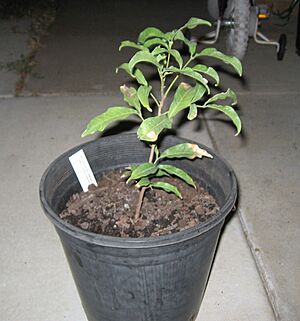Diploglottis facts for kids
Quick facts for kids Diploglottis |
|
|---|---|
 |
|
| Diploglottis australis | |
| Scientific classification |
|
| Kingdom: | Plantae |
| Clade: | Tracheophytes |
| Clade: | Angiosperms |
| Clade: | Eudicots |
| Clade: | Rosids |
| Order: | Sapindales |
| Family: | Sapindaceae |
| Subfamily: | Sapindoideae |
| Genus: | Diploglottis Hook.f. |
| Species | |
|
See text |
|
Diploglottis is a group of 10 types of trees. They belong to the Sapindaceae plant family. You can find them growing naturally in rainforests and humid forests in eastern Australia and New Guinea. Some of these trees are called native tamarind or small-leaved tamarind. But don't get confused! They are not related to the real tamarind fruit.
One Australian type, D. australis, is often planted as a street tree. You can see many of them in the Northern Rivers area of New South Wales, especially in Lismore. People there call it the native tamarind.
Another special Australian type is D. campbellii, also known as the small-leaved tamarind. This tree is quite rare and in danger. There are only a few places where it grows, and each spot has only up to three trees. In total, there are only 42 known wild adult trees in south-east Queensland and north-eastern New South Wales. However, you can easily buy young D. campbellii trees from plant shops in the Northern Rivers area of New South Wales and south-eastern Queensland. The small-leaved tamarind can grow up to 30 metres tall. It has a thick, bushy top, which makes it great for creating a natural screen. Its fruit is small and has three parts. This fruit is edible and is even sold as bushfood. When it's ripe, it turns red and can be used to make delicious jam!
Contents
Discovering and Naming These Trees
Scientists have been studying Diploglottis trees for a long time. The D. australis was one of the first types that European scientists collected. For example, a botanist named Robert Brown collected samples in 1804.
In 1862, Joseph Dalton Hooker officially gave the group of trees the name Diploglottis. Over the years, different scientists gave these trees different names. It can be a bit confusing, but scientists work hard to make sure each plant has one correct name that everyone agrees on. This helps them study and protect plants better.
Different Types of Diploglottis Trees
Here are the 10 known types of Diploglottis trees:
- D. australis (G.Don) Radlk.; also known as Native tamarind – Found in eastern New South Wales and Queensland, Australia.
- D. bernieana S.T.Reynolds – Found in north-eastern Queensland, Australia.
- D. bracteata Leenh. – Found in north-eastern Queensland, Australia.
- D. campbellii Cheel; also known as Small-leaved tamarind – Found in south-eastern Queensland and north-eastern New South Wales, Australia.
- D. diphyllostegia (F.Muell.) F.M.Bailey – Found in central to north-eastern Queensland, Australia, and New Guinea.
- D. harpullioides S.T.Reynolds – Found in north-eastern Queensland, Australia.
- D. macrantha S.T.Reynolds – Found in north-eastern Queensland, Australia.
- D. obovata S.T.Reynolds – Found in central Queensland, Australia.
- D. pedleyi S.T.Reynolds – Found in north-eastern Queensland, Australia.
- D. smithii S.T.Reynolds – Found in north-eastern Queensland, Australia.
Who Eats Diploglottis Trees?
Some types of Diploglottis trees are food for certain moths. For example, the caterpillars of the Aenetus ramsayi and Aenetus scotti moths (which are a type of hepialid moth) like to munch on these trees.
See also
 In Spanish: Diploglottis para niños
In Spanish: Diploglottis para niños


